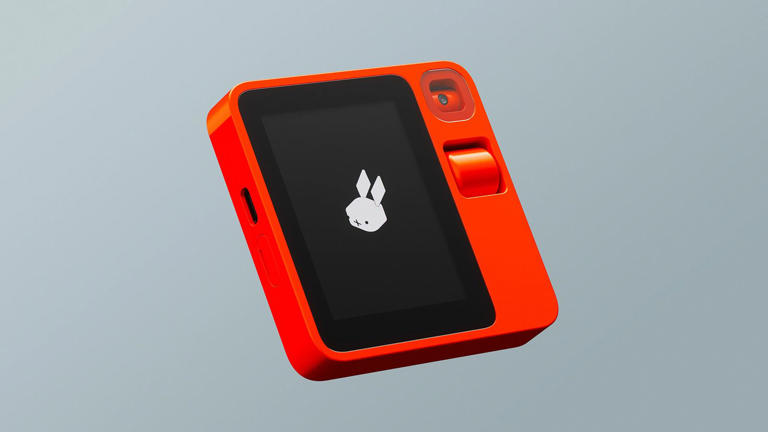How the Rabbit R1 next-gen AI assistant is a new force for digital inclusion
Robin Christopherson | 05 Apr 2024In a world where complex, confusing and often inaccessible digital interfaces pose barriers for disabled individuals, a new development in digital assistants promises to be a radical step-change in inclusivity.
In eye-catching orange, the Rabbit R1 is a compact, palm-sized device that hides a whole range of revolutionary capabilities. Even though the R1 will start shipping with a shortlist of such smarts, it will still mark a step-change in utility for almost every user – and the promise is enormous.

(Image sourced from the rabbit.tech website.)
What’s so different about this tiny device? Let’s delve into how this Artificial Intelligence (AI) companion, armed with cutting-edge AI, promises to reshape our interactions with both the digital realm and the real world.
Large Action Model (LAM): Bridging intent and action
At this point, we’ve almost certainly all heard of LLMs (Large Language Models) such as Open AI’s Chat GPT or Google’s Gemini. Whilst the Rabbit R1 undoubtedly includes such AI smarts that offer intuitive, chat-based interactions, at the heart of the Rabbit R1 lies the really innovative Large Action Model (LAM).
 Free webinar on Artificial Intelligence (AI)
Free webinar on Artificial Intelligence (AI)Learn more about how AI can help disabled people in our free webinar recording. Watch the webinar playback
Unlike traditional AI models that merely retrieve information, LAMs understand complex requests and execute tasks. Trained on screenshots and videos of common apps, the Rabbit R1’s LAM navigates interfaces like a seasoned user. Imagine asking it to play your favourite Spotify track—it knows the steps and performs them seamlessly even though Spotify hasn’t helped in the process by providing an official integration into its service. This is the true innovation of the LAM.
Many companies have provided an official integration for third-party providers to interface with their services. Called APIs (Application Programming Interfaces), they allow a smart assistant or other app to access their services to, for example, order fast food or a flight to a far-flung country.
But not every online service has an API–only a tiny fraction compared to the number of websites and apps that are out there on the interweb. More often than not you are required to undertake complex and often confusing multi-stage tasks with varying levels of stress and success. Now add in a disability or impairment that might make such tasks much harder or impossible, and you begin to see where a truly useful virtual assistant that could take these tasks off your hands would be a game changer for everyone.
Teach Mode: Using AI to learn complex tasks
The Rabbit R1 has a dedicated training mode that allows users to teach it specific tasks on a website, for example, and it is then able to do those clicks and key presses for you from then on. As it learns, it adapts to new applications, expanding its capabilities beyond pre-taught journeys. It will also remember your information for entering next time. If the site changes, no problem. The AI can intuitively understand screens to know what to do.
Teach the Rabbit about a local grocery store website that offers no such integration and it’s plain sailing from that point on. For a blind person like myself, I can simply ask for what I need to be ordered and it’ll arrive. Alternatively, I could point the camera on the R1 into my cupboards or fridge and it’ll see which items that I usually keep are missing and will quickly and quietly open up that website and pop those in my basket for the next shop – and I haven’t even had to open my phone, let alone deal with the dozens of buttons and fields I’d normally need to interact with if I were doing it myself (assuming that the website is accessible, of course, which is by no means a given).
Real-world interaction via built-in sensors and connected devices
So the Rabbit R1 can apply its AI smarts to a range of online tasks hitherto unreachable by any other assistant - that’s its real innovation - but it can, of course, also interface with all your existing smart home devices and services. It can change the temperature on your smart thermostat, turn connected lights and other devices on and off and show you the feed from your security cameras – as other smart hubs can.
It also interacts with the real world using sensors of its own. Equipped with a 360-degree rotating camera, speakers, and microphones, it can perceive and understand a lot about its surroundings.
Want to recognise objects, text, or people? It’s got you covered. Need to translate someone’s speech into text, or filter out noise to help you listen to a conversation, AI is to the rescue.
For disabled users, the R1s sensors can help assist their own senses, which translates to newfound independence in managing daily tasks.
A future of inclusivity
For those who struggle with practical real-world tasks, or complex online processes, the Rabbit R1 has the promise to be a real game-changer. It doesn’t overwhelm you with standalone apps; instead, it connects to your smartphone and provides an alternative, entirely different and much more intuitive interface.
Rabbit OS, the R1’s proprietary operating system, affords this much more efficient digital experience. Whether it’s booking rides, finding recipes, or managing household duties, this innovative device should help simplify the complex and allow many more people to engage with their tech and the digital world at large.
The Rabbit R1 promises to be more than yet another virtual assistant; it might even represent a paradigm shift towards an age of much greater simplicity and convenience.
For disabled people, it’s not just about convenience; it’s about empowerment. From practical tasks to intricate online interactions, the Rabbit R1 bridges the often gaping inaccessibility and complexity gap, making technology accessible to all.
It’s still early days, and much of what may make the Rabbit a true innovation is still to be fully realised, but the new concept of a Large Action Model (with the agency needed to do so much more than the current crop of AIs) is exciting in the extreme. So, whether you’re adjusting your smart home settings or exploring new websites, consider letting a Rabbit be your capable companion on this new, more inclusive journey.



